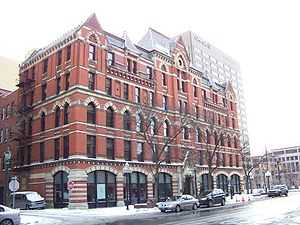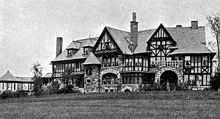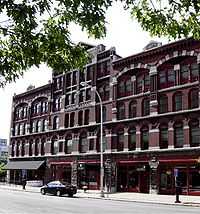Joseph Lyman Silsbee


Joseph Lyman Silsbee(1848–1913) was a significant American architect during the 19th and 20th centuries. He was well known for his facility of drawing and gift for designing buildings in a variety of styles. His most prominent works ran through Syracuse, Buffalo and Chicago He was influential as mentor to a generation of architects, most notably architects of the Prairie School including the famous architect Frank Lloyd Wright.
Biography
Born in 1848 at Salem, Massachusetts, Joseph Lyman Silsbee graduated from Phillips Exeter Academy[1] and Harvard. He then became an early student of the first school of architecture in the United States, the Massachusetts Institute of Technology. Thereafter he served an apprenticeship with Boston architects Ware & Van Brundt and William Ralph Emerson, respectively. Silsbee traveled in Europe before moving to Syracuse, New York in 1874. In 1875 he married Anna Baldwin Sedgwick, daughter of influential lawyer and politician Charles Baldwin Sedgwick.
Silsbee practiced architecture from 1875 until his death in 1913. He had a prolific practice and at one point had three simultaneously operating offices. He had offices in Syracuse (1875–1885), Buffalo (Silsbee & Marling, 1882–1887), and Chicago (Silsbee and Kent, 1883–1884). From 1883–1885 his Syracuse office was a partnership with architect Ellis G. Hall. Silsbee's Chicago office had a number of architects who were later to become known in their own right, including: Frank Lloyd Wright, George Grant Elmslie, George W. Maher, and Irving Gill.
Silsbee was one of the first professors of architecture at Syracuse University, one of the earliest schools of architecture in the nation. He was a founding member of the Chicago and Illinois Chapters of the American Institute of Architects. In 1894 Silsbee was awarded the Peabody Medal by the Franklin Institute for his design for a Moving Sidewalk. This invention had its debut at the Worlds Columbian Exposition and saw usage in subsequent Worlds Fairs.
Architecture


Among his most prominent architectural works is the landmark Syracuse Savings Bank Building (1876). Built next to the Erie Canal on Clinton Square in Syracuse, it is often referred to as a textbook example of the High Victorian Gothic style. Silsbee also designed the White Memorial Building (1876), the Amos Block (1878), and the Oakwood Cemetery Chapel (1879–80), all extant in Syracuse. Upland Farm (1892), the lost mansion designed for Frederick R. and Dora Sedgwick Hazard in nearby Solvay, New York is an example of the fashionable residential work that Silsbee was best known for. Photographs of these works are linked below.
Silsbee designed the lavish interiors of Potter Palmer's "castle" in Chicago. Several of his residential designs survive in Riverside, and Evanston Illinois. His most prominent surviving work in Chicago is the Lincoln Park Conservatory. Silsbee designed the movable walkway at the World's Columbian Exposition pier in 1893, and submitted plans to provide this improvement for the Brooklyn Bridge in 1894,[2] although these plans were never executed.
References
- Joseph Lyman Silsbee at buffalo.edu
- Joseph Lyman Silsbee, Syracuse
- Syracuse-Onondaga County Planning Agency (1975). Onondaga Landmarks.
- Harley McKee, Patricia Earle, Paul Malo (1964). Architecture Worth Saving in Onondaga County. Syracuse: Syracuse University Press.
- Angela Hess. "Joseph Lyman Silsbee"
Notes
- ↑ "General catalogue of officers and students, 1783-1903. (page 10 of 31)". Phillips Exeter Academy. Retrieved 2011-01-13.
- ↑ "Movable Walk for the Big Bridge - Chicago Speed to be Applied to the present Slow Transportation Facilities". Chicago Daily Tribune: 8. April 20, 1894.
External links
- Syracuse Savings Bank photographs
- White Memorial Building photographs
- Amos Block photographs
- Oakwood Memorial Chapel photographs
- Hazard Mansion photographs
|